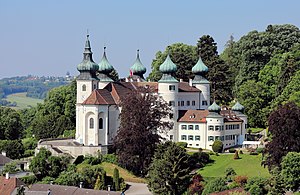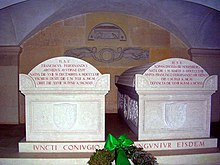Artstetten Castle
| Artstetten Castle | ||
|---|---|---|
|
Aerial view of the plant |
||
| Creation time : | 1560-92 | |
| Conservation status: | Received or received substantial parts | |
| Geographical location | 48 ° 14 '33.1 " N , 15 ° 12' 9.3" E | |
| Height: | 401 m above sea level A. | |
|
|
||

Artstetten Castle is a castle in the market town of Artstetten-Pöbring in the Melk district in Lower Austria owned by the Hohenberg family .
history
The building, first mentioned in a document in 1263, was owned by the von Aerendorf family until the 15th century. The current Renaissance building was built by Matthäus Gundreching in 1560–1592.
After several changes of ownership, the Austrian imperial family acquired the castle in 1823 . It was intended as a widow's residence for Empress Karolina Augusta , who, however, did not become a widow until 1835. In 1835 the castle came into the possession of Archduke Franz Karl , father of Emperor Franz Joseph I , who ruled from 1848 to 1916 , and in 1861 into the possession of Karl Ludwig , brother of Franz Joseph I. Archduke Ferdinand Maximilian also appears to be the buyer in 1866 , the future Emperor of Mexico, who never paid for it, which is why Karl Ludwig remained the owner. His son, Franz Ferdinand von Österreich-Este , heir to the throne from 1896 , received it from him in 1889 . Under his aegis, both the castle and the park were rebuilt and modernized.
In 1914, after the assassination attempt in Sarajevo, the eldest son of the heir to the throne, Maximilian Duke von Hohenberg , inherited the castle, who was then 12 years old. With the Nobility Repeal Act of 1919, the nobility in the Republic of Austria lost their naming rights. After the "Anschluss" in 1938 Maximilian Hohenberg was expropriated and one of the first Austrians to be deported to the Dachau concentration camp with his brother Ernst Hohenberg . The expropriated family property came to the Republic of Austria after the time of National Socialism .
In 1949 the castle was restituted by the Republic of Austria to Maximilian Hohenberg , who bequeathed it to his son Franz in 1962.
After Franz Hohenberg's death in 1977, his widow, Elisabeth von Luxemburg , transferred the estate in Artstetten with the castle, museum, forestry and agriculture to her eldest daughter Anita, who with her husband, the French Count de La Poeze d'Harambure , became the Archduke in 1982 -Franz-Ferdinand-Museum and renovated the castle. From this marriage there were four children who are now committed to the historical legacy. The castle and all of the lands have been owned by the Anita Hohenberg Foundation since 2003 .
Archduke Franz Ferdinand Museum
In 1982, the Archduke Franz Ferdinand Museum was set up in an additional part of the complex. The first exhibition, From Mayerling to Sarajewo , was replaced by an exhibition entitled Throne or Love . In addition, special exhibitions are held every year. These include:
- 1987: Children's drawings by Emperor Franz Joseph
- 1988: Maximilian Kaiser of Mexico
- 1989: The green world of the Habsburgs
- 1991: throne or love
- 1993: 100 years of the world tour of the heir to the throne
- 1994: Sarajevo 1914
- 1996: Archduke Carl Ludwig, father of the heir to the throne
- 1998: Art and the fascination of China
- 2000: 100 years of the marriage of Franz Ferdinand and Sophie Chotek
- 2001: A ship will come
- 2003: The Heir apparent and the architecture
- 2005: The Hohenberg House: prevented dynasty
- 2007: Servant Stories
- 2009: the boudoir and its secrets
- 2010: Everyone's Throne
- 2011: Well protected
- 2014: rule and lose
- 2016: Leopold Forstner
- 2017: The good tone
- 2018: Archduke Franz Ferdinand and the First World War
- 2019: With heart and hand for the alpine country
Castle archive
The castle archive, which is privately owned and partially accessible to the public, has grown naturally, but is nevertheless important for the history of Austria and the private life of the imperial families. The manor and estate archive has been completely preserved since it was bought by Emperor Franz I (1823). It serves to create the many special exhibitions, which is also a reason for a thematic inventory. In the course of the creation of the museum in 1982, it was compiled by Romée de La Poeze d´Harambure with the help of the historian Wladimir Aichelburg and stored in special rooms. In 2011 the owner of the castle Anita Hohenberg carried out a complete adaptation and modernization.
Parish church and family crypt
The castle and parish church " St. Jakobus the Elder " stands on the east side of the castle and is connected by a staircase to the lower-lying Artstetten-Pöbring market . The originally free-standing Gothic church was expanded into a baroque hall building in 1691–1698 and extended to the castle. Before the First World War, under Archduke Franz Ferdinand , the parish church was redesigned in the style of historicism .
In 1909 Franz Ferdinand commissioned the construction of a family crypt for twelve coffins under the forecourt of the parish church. Since his wife Sophie , Duchess of Hohenberg, could not be buried in the Capuchin crypt because of her disproportionate origin from the emperor's point of view , a crypt was built under the castle and parish church, where she was also buried. He, too, decided not to have a funeral in Vienna and was also buried in the Artstetten crypt, as he wished. On the common base are the words “Linked by the bond of marriage, united by the same fate”. In 1955/56, after the death of Ernst Hohenberg , the crypt was expanded under the church tower and the south terrace of the palace. These and the forecourt of the church were renovated in 1985. Today, in addition to the two sons and their wives, three grandchildren of Archduke Franz Ferdinand and Elisabeth of Luxembourg are buried here. The old castle crypt, which is located directly below the church, is dedicated to the descendants of the marriage Anita Hohenberg and Count Romée de La Poeze d´Harambure.
Castle Park
The palace park, the older state of which has hardly been passed down, was designed under Karl Ludwig from 1861 as a landscape garden of historicism , and in the complex that has basically been preserved to this day, it goes back to this phase of construction. In the garden there is an octagonal garden house with a drum-like upper floor, a tent roof and a spiral staircase . In front of it there is a water basin set in stone. Two fountain figures come from the 19th century.
The two driveways, the prestigious driveway south and the automobile road north, were laid out by Franz Ferdinand around 1900, the formal, terraced parts near the castle, already in a more modern style, were designed by the architect Rudolf Frass and the Czech horticultural artist Jaroslav Molnár in 1914. The park was also gradually expanded and redesigned later, with parts lying higher up in the adjacent forest area.
Today the park is characterized by its lively garden design and a collection of botanical rarities. It is one of the most important garden architectural monuments in Austria and is under monument protection ( No. 9 in the appendix to Section 1, Paragraph 12 of the DMSG and in the list of monuments ). The most important parts of it are accessible to museum visitors and at public events; some parts are private.
Others
- 1986: Installation of a memorial plaque for Archduke Franz Ferdinand and the Duchess of Hohenberg in the Capuchin Crypt in Vienna, unveiled by Cardinal Franz König
- 1988: Awarded the Wachau gold bonnet in silver
- 1990: Award of the Lower Austrian State Prize for the founder of the museum: Romée de La Poeze d´Harambure
- 1991: Artstetten Castle becomes the main location for the 11-part TV series Danube Princess
- 2004: A 10 euro coin from the Austrian National Bank was dedicated to Artstetten Castle.
- 2014: Commemoration on the occasion of the 100th return of the assassination attempt in Sarajevo, held by Cardinal Schönborn, followed by the opening of the exhibition by Governor Erwin Pröll
literature
- Castles, monasteries and chateaus, Waldviertel, Danube region, South Bohemia, Vysočina, South Moravia regions ISBN 978-3-9502262-2-5 , p. 16 ff.
- Falko Daim , Karin Kühtreiber, Thomas Kühtreiber : Castles - Waldviertel, Wachau, Moravian Thayatal . 2nd Edition. Freytag & Berndt Verlag, Vienna 2009, ISBN 978-3-7079-1273-9 , pp. 68-70.
- Christiane Scholler: Welcome to the palace. Artstetten Castle, 2011, ISBN 978-3-200-02192-1 .
- Gerhard Stenzel: From castle to castle in Austria . Kremayr & Scheriau, Vienna 1976, ISBN 3-218-00288-5 , p. OA
- Wladimir Aichelburg: Archduke Franz Ferdinand and Artstetten. Orac, Vienna 1986, ISBN 3-7015-0010-X .
- Wladimir Aichelburg: Archduke Franz Ferdinand of Austria Este and Artstetten. Via Imperialis, Vienna 2000, ISBN 3-901749-18-7 .
Web links
- Web presence of Schloss Artstetten (schloss-artstetten.at)
- Entry about Artstetten Castle on Lower Austria Castles online - Institute for Reality Studies of the Middle Ages and the Early Modern Era, University of Salzburg
- Entry via Artstetten to Burgen-Austria
- Entry on Artstetten Castle in the Austria Forum (in the Heimatlexikon)
Individual evidence
- ↑ a b c d Géza Hajós; Matthias Cremer (Ill.): Historical gardens in Austria: forgotten total works of art. Austrian Society for Historical Gardens, Böhlau Verlag Vienna, 1993, ISBN 978-320598095-7 , Der Schloßpark von Artstetten , p. 48 ff ( limited preview in the Google book search).
- ↑ Lit. Aichelburg 2000, p. OA
- ^ Archives Schloss Artstetten / Gruft / Contract> and <Archives Schloss Artstetten / Patronage / Correspondence / Gruft
- ^ Eva Berger: Historical Gardens of Austria: Gardens and parks from the Renaissance to around 1930 . tape 1 Lower Austria, Burgenland . Böhlau Verlag, Vienna 2002, ISBN 978-3-205-99352-0 , Artstetten, Schloßpark , p. 104 ff . ( limited preview in Google Book search).
- ↑ a b c Entry about Artstetten on Burgen-Austria
- ↑ Entry on Artstetten Castle in the Austria Forum (in the coin album)



